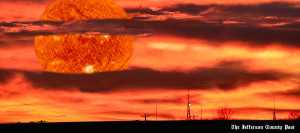Winter Solstice in Northern Hemisphere
 December 21 marks the Winter Solstice in the Northern Hemisphere, an astronomical event that has been celebrated by dozens of cultures and religions, and that has historically been used as a seasonal indicator. The Winter Solstice is, scientifically, the instant that the sun’s maximum elevation in the day (noon) is at its lowest. In other words, the Winter Solstice marks the exact turning point in the cycle of days getting shorter and nights growing in length, making December 21, or sometimes 22, the shortest “day” of the year. The solstice is often misunderstood as the first day of winter. In actuality, winter occurs following the point where the sun is the farthest south in the year for that hemisphere. The solstice is an exact moment in time, while the day it falls on is referred to as “midwinter,” among other names. This means that winter, while commonly indicated by the solstice, does not actually occur at the same time. Culturally, the solstice’s utility as a marker for the shortening of days and lengthening of nights makes it useful as a harvest or livestock mating indicator. Due to the fact that it is the turning point in the cycle, the Winter Solstice has often been used to symbolize rebirth, and many religious or cultural holidays align with the time. Under the Julian Calendar, the Roman Winter Solstice falls upon the 25th of December, and was chosen as the most suitable day in which to celebrate Christmas.
December 21 marks the Winter Solstice in the Northern Hemisphere, an astronomical event that has been celebrated by dozens of cultures and religions, and that has historically been used as a seasonal indicator. The Winter Solstice is, scientifically, the instant that the sun’s maximum elevation in the day (noon) is at its lowest. In other words, the Winter Solstice marks the exact turning point in the cycle of days getting shorter and nights growing in length, making December 21, or sometimes 22, the shortest “day” of the year. The solstice is often misunderstood as the first day of winter. In actuality, winter occurs following the point where the sun is the farthest south in the year for that hemisphere. The solstice is an exact moment in time, while the day it falls on is referred to as “midwinter,” among other names. This means that winter, while commonly indicated by the solstice, does not actually occur at the same time. Culturally, the solstice’s utility as a marker for the shortening of days and lengthening of nights makes it useful as a harvest or livestock mating indicator. Due to the fact that it is the turning point in the cycle, the Winter Solstice has often been used to symbolize rebirth, and many religious or cultural holidays align with the time. Under the Julian Calendar, the Roman Winter Solstice falls upon the 25th of December, and was chosen as the most suitable day in which to celebrate Christmas.









